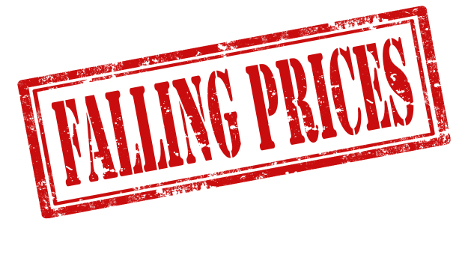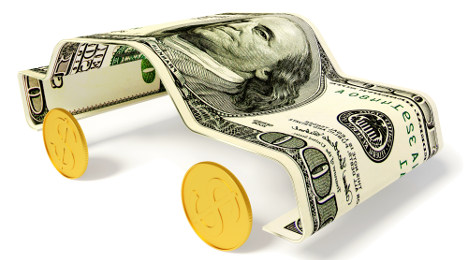Used-vehicle prices were down this past February, and the trend isn’t expected to stop anytime soon.
According to the latest RVI Risk Outlook report, greater incentive activity and a more competitive new-vehicle market — as well as increasing used supply — will combine to put even more downward pressure on pre-owned prices.
“The upturn in the U.S economy and the increase in new-vehicle sales are expected to contribute to an increase in the supply of used vehicles over the next few years. Competition among manufacturers and incentives activity is also expected to increase,” the report stated. “Due to these factors, used-vehicle prices in the U.S. are expected to fall 10 percent (relative to current levels) by 2018.”
The industry is expecting a surge of off-lease vehicles to hit the auctions this year, and it seems the trend will continue into coming years, as well, judging by 2014 statistics.
According to the report, 2014 was a strong year for leasing. In the fourth quarter, the lease penetration rate was 19.5 percent, and in 2014 as a whole, leasing accounted for 19.6 percent of U.S. new auto sales.
“We expect a higher lease penetration to continue for 2015 and 2016 model year vehicles,” RVI analysts predicted.
This past month, used-vehicle prices were already on the way down. According to the report, used prices, seasonally adjusted for vehicles 2 years to 5 years old, had fallen off 1.1 percent from January, according to RVI data.
Taking a look at recent residual movement by segment, full-size pickup prices were one of the best performing groups. This segment saw a slight decline of 0.3 percent, much lower than the average for February.
That said, RVI analysts said the used supply of full-size pickups is expected to ramp up in coming months, putting downward pressure on used prices for this segment.
In February, used supply of full-size pickups was already up by 4.5 percent year-over-year.
RVI expects this segment to see a price drop of 14.5 percent by 2018, caused in part to excess used supply as well as an expected rise in long-term gas prices.
On the other end of the retention spectrum last month, the luxury full-size sedan saw the largest drop in price, falling by 4.1 percent from January.
The luxury SUV (up 0.9 percent) and the full-size van segment ( up0.2 percent) were the only segments to see prices rise at all last month, according to the RVI report.
Many dealers have come to expect tax season price and sales strength in the smaller and entry-level car segments, known for tax-return draw.
But this year, according to the latest weekly Black Book Market Insights report, tax season impacted a much broader swath of vehicle segments.
According to the report, Black Book data shows strength in additional segments, such as entry-midsize, full-size and upper-midsize car segments, as well as compact SUVs on the truck side.
Reinforcing this assertion was comments Black Book analysts heard coming out of the auction lanes last week, such as “Anything under $10,000 was in demand,” from an auction in Pennsylvania, as well as “Almost all segments seemed strong” — a comment stemming from an auction in California.
Last week, the entry level cars saw a spike of .18 percent (or $11), while the entry-midsize and full-size car segments both saw prices rise by $19.
Interestingly, the upper midsize car segment saw the largest price increase for the cars last week, rising by $33, or .33 percent.
And compact SUVs, another segment being positively impacted by tax return dollars, saw prices rise by $64 (.36 percent).
“The improved economy and still-low gas prices are resulting in broad strength in the market as a more diverse set of segments are getting looks from the buyers,” said Anil Goyal, vice president of automotive valuation and analytics at Black Book.
Goyal also pointed out low fuel prices could also be playing a role in equalizing demand for full-size cars as well as some of the higher volume truck segments, such as compact SUVS (+$64), compact CUVs (+$8) and full-size SUVs (+$12).
Gas prices continue to drop, falling by 3 cents last week to an average of $2.45 per gallon.
The inaugural issue of Black Book Market Insights — a weekly report focused on the latest vehicle valuation trends at auction by Black Book’s team of editors — focused on tax season trends in the lanes and how the impact of refunds is hitting the market a bit later than normal this year.
The industry has become accustomed to receiving weekly auction updates via Black Book’s “Beggs on the Used Car Market Report,” but in light of editorial director Ricky Beggs’ upcoming retirement, the company has launched this weekly newsletter to fill the spot.
The inaugural report, delivered Wednesday, focused on tax season trends in the lanes. Black Book pointed out that traditionally, values for lower-prices cars and trucks start to spike in by early to mid March in connection with tax season trends.
But this year, according to Black Book, tax season in the auto industry began a little earlier, starting to impact the auctions in late 2014.
Consequently, we may not see the dramatic price increases expected during this time of year.
Furthermore, the vehicles normally in tax season demand may be a bit different, as well.
According to the report, with gas prices still low, buyers may be looking to use their refunds for full-size trucks, SUVs and full-size cars.
“Although gas prices have picked up in recent weeks, they remain historically low. Sustained lower gas prices would be positive for vehicle sales and value retention, especially less-fuel efficient light trucks,” said Anil Goyal, vice president of automotive valuation and analytics at Black Book.
Of course, entry-level cars will remain a popular buy for tax refund money, but the pool of segments shoppers may be considering is growing.
“Entry level cars are starting to show seasonal strength in value driven by demand from the tax season buyer while the luxury segments show some weakness,” Goyal added.
These trends are illustrated by last week’s auction price movement.
Entry-level cars saw a 0.31 percent or $19 increase in price last week, due in part to dealers who are still preparing for tax refund buyers, Black Book pointed out.
Overall, the car segments saw an average price drop of 0.09 or $9 last week.
“This is stronger than the retention we have seen in the previous two weeks,” the report stated.
And the trucks saw prices stay pretty steady, as well, only dropping by an average of 0.23 percent or $34 last week.
Segments performing poorly last week, on the other hand, were the luxury car and luxury SUV segments — which are not traditionally associated with tax season buys. These two segments had the highest dollar price declines last week, with the luxury SUV segment experiencing a $140 or 0.54 percent drop, while the luxury cars saw prices drop by 0.33 percent or $57.
Black Book closed the new report by sharing what editors are hearing and seeing in the lanes since they attend more than 60 auctions each week throughout the country. Here’s the latest sampling:
From Minneapolis, “Internet activity was strong on late model clean and extra clean units with lower mileage.”
And this comment coming out of Nashville, Tenn., “Dealers stocking up units for tax time.
Two other comments from Florida and California summarized the bidding activity.
Out of the Sunshine State, “Sellers on the block feel they can hold out for more money but buyers were only willing to pay book value and not more,” while seen in the Golden State, “Strong bidding from both attendees and Internet buyers today.”
Wholesale prices last month softened 0.3 percent from January, but still beat year-ago levels by more than 3 percent. The reason, says ADESA’s Tom Kontos, has a lot to do with the supply of off-rental program/factory vehicles.
Specifically, the latest Kontos Kommentary report put out by ADESA Analytical Services indicates that the average wholesale price in February was $10,176. This was off 0.3 percent month-over-month but represents a 3.4-percent upswing from February 2014.
Kontos said the increase was “primarily due to a ‘richer mix’ that includes a higher proportion and quantity of off-rental program/factory units.”
Adding some more context to that, he noted in the report: “As in January, much of the positive year-over-year price variance is driven by higher off-rental program/factory vehicle sales.
“Program vehicles are typically current-model-year or one-year-old models that sell for higher average prices than other auction sales types.”
After seven years and 488 videos, Monday was the final edition of the “Beggs on the Used Car Market” report, as Ricky Beggs — auto analyst extraordinaire and staunch Georgia Bulldogs supporter — gets set to retire on April 1.
But before the Black Book senior vice president and editorial director signed off for a final time, he did as he always does, and that was to give an in-depth look at all the pricing moves in the wholesale market.
“This past month brought pretty solid overall values as the depreciation was at -1.2 percent, the same level as January results. But there are differences. The industry is right in the middle of the typical tax season,” Beggs said. “As we have tracked and reported the used market, there was an exceptionally active and strong November and December with a true focus on the models that generally fare better during the first of the year.
“January results had eight segments with depreciation less than -1.0 percent. The three best segments were car-related and two of those were the entry-level cars and the compact cars, both at -0.5 percent,” he added. “These are the lowest average price segments that generally get the most tax season type attention, regardless of the price of gas.
“As we moved through February and into March the market results at the same -1.2 percent depreciation had nine segments at less than -1.0 percent,” Beggs continued.
Where the difference occurred, he said, was in the entry-level cars and compact cars, which are some of the popular lower-priced car segments. Their depreciation levels (-1.38 percent for entry-level, -1.64 percent for compacts) were above average.
“What we see in this is that the tax season buying strength started earlier than normal, as far back as November 2014 and thus might have peaked and turned earlier in the calendar this year,” Beggs explained.
Moving on to trucks, their values fell 1.0 percent overall for February. Beggs pointed out strong values for compact SUVs, midsize SUVs and compact crossovers.
Additionally, he said, the full-size pickup — with robust demand in the new- and used-car markets — was strong over the last month, with values falling just 0.6 percent.
“A segment we have been reporting solid levels of pricing now for a full year is the full-size vans, both cargo and passenger versions. The cargo vans were at only -0.4 percent this past month,” Beggs said. “Another seasonal movement we have become accustomed to is the increase of gas prices right after the calendar year turns. Fortunately for this year the starting point is much lower by about $1.12, and the market reaction to this has been almost unnoticed.”
Insight Will Continue
Sharing more about his upcoming retirement and Black Book’s plans going forward, Beggs had this to say: “As I mentioned earlier this is the final weekly video blog. Black Book will continue to offer insight into the market via the Black Book Market Insights report, with similar information you are accustomed to along with additional analytical data. Be sure to click on the link here to ensure delivery of this important weekly insight.
“As for the video, I couldn’t have imagined almost seven years ago in the summer of 2008 when Black Book president Tom Cross suggested sharing our market insight with a video blog that it would have continued this long or have grown into the significant following of viewers. Even the comments and feedback were astounding at times,” Beggs continued. “We were fortunate enough to bring you market insight every week covering the automotive market since 2008 and also four full years of monthly specialty market videos.
“All totaled up that comes to 488 videos. Thank you very much for your time and interest in these videos. We trust they added something that helped your business be a little more successful.”
He would go on to conclude his last post with this: “As we sign off this final time, again I thank you for your viewing and interest into these market based video blogs, but even more so for your use of the Black Book products and services. It was a pleasure and an honor to communicate with you in this format. Don’t forget that we will be looking for you on the auction lanes. Have a great week. It’s been a fantastic ride!”
Low gas prices and lots of winter weather compounded to bring strength to SUV prices at auction last month.
According to the latest data from Black Book, the average price of a used vehicle for model years 2009-2013 dropped by an average of 1.2 percent in February, which showed no change from January depreciation.
SUVs and trucks bucked trends with much lower-than-average depreciation last month.
The compact SUV segment led the month with the strongest retention rate, according to Black Book, with prices rising by 0.9 percent in February.
This was the only segment that finished the month off with a price increase, one that includes the Jeep Wrangler and Nissan Xterra. Vehicles in this segment finished the month off with an average price of $19,398, representing a 2.9-percent drop from year-ago prices.
Trucks touted seven of the eight best-performing segments, Black book personnel also pointed out.
“Perhaps the colder weather patterns helped heat up the sport utility vehicle and truck segments during February, as we saw great strength in SUVs and crossovers,” said Ricky Beggs, editorial director at Black Book. “Furthermore, while overall depreciation finished at -1.2 percent on the month, there are segments we feel could turn more positive due to spring type activity and continuing economic improvement. Also, some of the typical tax season cars might have reached their peak earlier in the calendar than last normal seasonal patterns.”
The only car segment hanging with the trucks in terms of retention was the upper midsize cars. This segment saw prices drop by only 0.3 percent, the third-best overall retention rate for February. Vehicles in this segment finished the month off with an average price of $10,924.
On the other hand, prestige luxury cars saw the largest depreciation during January, with a price drop of 2.8 percent.
Vehicles in this segment, which include the Audi A8 and Lexus GS, finished the month off with an average price of $34,714.
The last week of February — although snowy — was a positive one in the auction lanes, as both cars and trucks saw the lowest price drops experienced over the past three weeks.
“This is an expected trend based on seasonality patterns that we have tracked and studied for the past decade,” said Black Book editorial director Ricky Beggs in his lastest “Beggs on the Used Car Market” video report.
Last week, 40 percent of all price adjustments at auction were increases.
And for the first time in nine weeks, one of the car segments saw a rise in price, albeit slight. Last week, the full-size cars saw prices rise by $5, after seeing a $4 decline the week before.
The entry level cars and upper-midsize cars are also seeing stable pricing, falling by $3 and $12 last week, respectively.
Strong residuals for these segments are “being driven by demand in the ‘tax season’ market,” said Beggs.
“Overall the -$40 average segment change for the cars was half of the year-ago (change of) -$81, when the extremely harsh winter weather was adversely affecting the market,” Beggs continued.
The trucks also experienced the lowest weekly average change in the past three weeks, with a slight average decline of $33.
That said, Beggs pointed out there are a few segments still seeing larger-than-normal price drops.
For example, the luxury SUVs saw prices drop by $158 last week, and the full-size SUVs declined by $84.
“Both of these were lower declines than the prior week, but still adjusting and still finding a new market level,” Beggs said.
Though SUV prices may be wavering, demand for pickups remains strong.
The midsize pickups saw prices rise by $21 this past week. And the full-size cargo vans, “continue their demand in the used market by the buyers,” Beggs said. Last week the full-size cargo vans saw prices spike by $57, after prices rose by $70 the prior week.
To view the latest “Beggs on the Used Car Market” report, see above.
Used-car prices in February have begun responding positively to the usual tax season surge, but prices were still dropping in the lanes during the first month of the year.
According to the RVI Used Vehicle Price Index, used prices dropped by 5.4 percent last month when compared to December.
Used prices were up just a slight 0.1 percent year-over-year last month.
According to the latest RVI Market Update, all the vehicle segments the company tracks saw prices drop in January.
And as gas prices fell for the seventh month in a row in January, down to an average of $2.21 per gallon, truck prices have been experiencing some positive impacts.
For example, the small pickup segment, which saw a 0.5-percent drop from December, and small SUVs, falling by 1.1 percent, both saw the slightest price drops last month.
On the other hand, the full-size sedans and luxury small sedans saw the greatest drops in residuals last month.
The full-size sedans saw prices drop by 9.6 percent from December and are also down 5.7 percent year-over-year; full-size van prices were also down by 9.6 percent from December.
The luxury small sedan category also experienced price drops, with an 8 percent decline from December, and a 6.5 percent drop year-over-year.
Moving closer toward spring, tax season is now making its mark as used-price movement has been more positive as of late.
For example, Black Book personnel said overall sales percentages were very good last week, and show a market that is holding steady.
Last week, of all price changes made at auction, just over 39 percent of those were price increases, according to Black Book data.
Think late January, when winter had been relatively mild so far, and it was easy to start looking toward spring — then February rolled along and changed the game.
This month brought with it record-low temperatures and snowfall across much of the United States, and this weather is impacting auto markets, as well, especially in the auction lanes.
According to the latest “Beggs on the Used Car Market” video report, Black Book’s editorial director Ricky Beggs said the past week’s extreme winter weather is impacting the auto markets.
“It is winter and we expect cold weather, but certain parts of the country have gotten more than their fair share. Even some of us in the Deep South had temperatures that registered in the single and low teen digits along with a couple of days of frozen precipitation,” said Beggs. “But in today’s market there are few exceptions where the weather actually stops a physical auction completely, as the ability to run an online and physical concurrent auction still will get cars sold.”
And though the show must go on, most of Black Book’s survey of auction personnel referenced the increasing cold.
That said, they also acknowledged overall sales percentages being very good, and a market that is holding steady, Beggs pointed out.
Last week, of all price changes made, just over 39 percent of those were price increases.
Beggs pointed out since the first week of the year, every week since has had over a 30-percent price increase rate, with three weeks approaching the 40-percent mark, which he said is a “great indicator of positive activity.”
The car segments saw prices drop by an average of $59 this past week.
Although six of the 10 car segments Black Book tracks had smaller price declines than the prior week, the premium sporty cars (-$213) and prestige luxury cars (-$147) tipped the scale.
And even though the overall car segment decline was up a bit from the previous week, Beggs said it still experienced positive change year-over-year.
Shifting gears, the truck markets “continue to be steady and stable overall since the first of the year,” Beggs said.
That said, a couple of SUV segments continue to see larger-than-average price drops.
During this week’s video, Beggs also touched on the topic of his impending retirement. The Black Book editorial director and senior vice president will be retiring on April 1 after a 34-year career.
Though the weekly video reports from Beggs will have to end, he assured viewers market insight will still be provided.
The newsletter series that will replace the video report will be titled “Black Book Market Insights.”
“It is designed to combine all of the timely, accurate vehicle valuation data that you've come to rely on Black Book for, with additional analytical insight that will help you make profitable decisions for your business each day,” said Beggs. “Every week the report will offer you a direct link to dealer sentiment at the auctions, in addition to broader economic trends that are shaping the automotive market.”
To see the latest "Beggs on the Used Car Market" video report, see above.
Gas prices fell dramatically during the second half of 2014 and still remain very low as 2015 gets underway and oil continues to lose value.
This has sparked a ripple effect throughout the automotive remarketing industry, turning many consumers toward truck and SUV purchases, as well as pushing prices up in the auction lanes for these very same vehicles.
And it seems to be impacting the leasing industry, as well, as recent data from Swapalease.com shows that there was a drastic increase in leasing trucks in 2014.
Expanding credit availability and lower fuel prices perhaps played a role in this movement, even though trucks traditionally haven’t made up a significant portion of the lease market.
According to Swapalease data, when comparing truck inventory and consideration data from 2014 against 2012, the site find that there has been significant growth in both the number of shoppers driving truck leases, and those looking for truck leases.
"It has always been interesting to see trucks as a top driver of overall sales historically without this translating over to lease activity," said Scot Hall, executive vice president at Swapalease. "I think what you're seeing today, however, is a shift among traditional drivers of trucks who now see the value of strong lease deals available for popular truck models. Furthermore, the typical driver of a truck has always had the mindset of holding onto that vehicle for a long period of time, and truck technology is now advancing and refreshing more frequently, giving rise to the number of drivers who wish to upgrade every few years."
On top is the Chevy Silverado, which has seen a 286.4-percent jump in Swapalease.com inventory and an 89.6-percent spike in shopping consideration over the last two years.
The Ford F-150 has also seen growth, as inventory for this model on the site has grown by 69 percent when compared to 2012, while searches jumped up by 89.6 percent.
The Dodge Ram 1500, another example of truck interest, saw a 79.3-percent jump in inventory and an 11.1-percent increase in searches.
Lastly, the Toyota Tundra saw an impressive jump of 110 percent in inventory and 27.6 percent in searches.
Interestingly, the increased interest in trucks also served to push average transaction prices up in the used market last year.
That’s according to analysts at Edmunds.com, whose latest Used Vehicle Market Report shows in 2014, the average 1-year-old vehicle sold for almost $30,000, which is 5.7 percent higher than in 2013.
Rapidly dropping gas prices played a role in boosting average retail used-car prices, Edmunds analysts pointed out.
According to the report, lower gas rates drew consumers toward larger, less fuel-efficient vehicles, which tend to tout higher price tags — such as trucks.
Also, as lower interest rates were more prevalent and longer loan-terms became the norm last year, shoppers were able to purchase more expensive used vehicles.
And dealers looking to ramp up used inventory of trucks to meet demand may be paying a bit more in the lanes.
According to the latest Guidelines report from NADA Used Car Guide, gas prices are also expected to play a part in ramping up truck prices during February and March.
Pickup prices were already on the way up during the first month of the year, with prices rising by 7.9 percent year-over-year, according to NADA UCG.











